Is there a way that I can use the Vision framework to scan an existing image from the user's photo library? As in, not taking a new picture using the camera, but just choosing an image that the user already has?
Asked
Active
Viewed 953 times
2
Asif Mujtaba
- 447
- 6
- 17
rice888
- 51
- 8
-
2Pretty sure you can do that, yes: https://developer.apple.com/documentation/vision/detecting_objects_in_still_images – luk2302 Jun 14 '20 at 14:31
2 Answers
2
Yes, you can. Adding on to @Zulqarnayn's answer, here's a working example to detect and draw a bounding box on rectangles.
1. Set up the image view where the image will be displayed
@IBOutlet weak var imageView: UIImageView!
@IBAction func pickImage(_ sender: Any) {
let picker = UIImagePickerController()
picker.delegate = self
self.present(picker, animated: true)
}
override func viewDidLoad() {
super.viewDidLoad()
imageView.layer.borderWidth = 4
imageView.layer.borderColor = UIColor.blue.cgColor
imageView.contentMode = .scaleAspectFill
imageView.backgroundColor = UIColor.green.withAlphaComponent(0.3)
imageView.layer.masksToBounds = false /// allow image to overflow, for testing purposes
}
2. Get the image from the image picker
extension ViewController: UIImagePickerControllerDelegate, UINavigationControllerDelegate {
func imagePickerController(_ picker: UIImagePickerController, didFinishPickingMediaWithInfo info: [UIImagePickerController.InfoKey : Any]) {
guard let image = info[.originalImage] as? UIImage else { return }
/// set the imageView's image
imageView.image = image
/// start the request & request handler
detectCard()
/// dismiss the picker
dismiss(animated: true)
}
}
3. Start the vision request
func detectCard() {
guard let cgImage = imageView.image?.cgImage else { return }
/// perform on background thread, so the main screen is not frozen
DispatchQueue.global(qos: .userInitiated).async {
let request = VNDetectRectanglesRequest { request, error in
/// this function will be called when the Vision request finishes
self.handleDetectedRectangle(request: request, error: error)
}
request.minimumAspectRatio = 0.0
request.maximumAspectRatio = 1.0
request.maximumObservations = 1 /// only look for 1 rectangle
let imageRequestHandler = VNImageRequestHandler(cgImage: cgImage, orientation: .up)
do {
try imageRequestHandler.perform([request])
} catch let error {
print("Error: \(error)")
}
}
}
4. Get the result from the Vision request
func handleDetectedRectangle(request: VNRequest?, error: Error?) {
if let results = request?.results {
if let observation = results.first as? VNRectangleObservation {
/// get back to the main thread
DispatchQueue.main.async {
guard let image = self.imageView.image else { return }
let convertedRect = self.getConvertedRect(
boundingBox: observation.boundingBox,
inImage: image.size,
containedIn: self.imageView.bounds.size
)
self.drawBoundingBox(rect: convertedRect)
}
}
}
}
5. Convert observation.boundingBox to the UIKit coordinates of the image view, then draw a border around the detected rectangle
I explain this more in detail in this answer.
func getConvertedRect(boundingBox: CGRect, inImage imageSize: CGSize, containedIn containerSize: CGSize) -> CGRect {
let rectOfImage: CGRect
let imageAspect = imageSize.width / imageSize.height
let containerAspect = containerSize.width / containerSize.height
if imageAspect > containerAspect { /// image extends left and right
let newImageWidth = containerSize.height * imageAspect /// the width of the overflowing image
let newX = -(newImageWidth - containerSize.width) / 2
rectOfImage = CGRect(x: newX, y: 0, width: newImageWidth, height: containerSize.height)
} else { /// image extends top and bottom
let newImageHeight = containerSize.width * (1 / imageAspect) /// the width of the overflowing image
let newY = -(newImageHeight - containerSize.height) / 2
rectOfImage = CGRect(x: 0, y: newY, width: containerSize.width, height: newImageHeight)
}
let newOriginBoundingBox = CGRect(
x: boundingBox.origin.x,
y: 1 - boundingBox.origin.y - boundingBox.height,
width: boundingBox.width,
height: boundingBox.height
)
var convertedRect = VNImageRectForNormalizedRect(newOriginBoundingBox, Int(rectOfImage.width), Int(rectOfImage.height))
/// add the margins
convertedRect.origin.x += rectOfImage.origin.x
convertedRect.origin.y += rectOfImage.origin.y
return convertedRect
}
/// draw an orange frame around the detected rectangle, on top of the image view
func drawBoundingBox(rect: CGRect) {
let uiView = UIView(frame: rect)
imageView.addSubview(uiView)
uiView.backgroundColor = UIColor.clear
uiView.layer.borderColor = UIColor.orange.cgColor
uiView.layer.borderWidth = 3
}
Result | Demo repo
aheze
- 24,434
- 8
- 68
- 125
1
Yes, you can. First, take an instance of UIImagePickerController & present it.
let picker = UIImagePickerController()
picker.delegate = self
picker.sourceType = .photoLibrary
present(picker, animated: true, completion: nil)
Then implement the delegate method take the desired image
extension YourViewController: UIImagePickerControllerDelegate {
func imagePickerController(_ picker: UIImagePickerController, didFinishPickingMediaWithInfo info: [UIImagePickerController.InfoKey : Any]) {
if let pickedImage = info[.originalImage] as? UIImage {
## here start your request & request handler
}
picker.dismiss(animated: true, completion: nil)
}
}
Asif Mujtaba
- 447
- 6
- 17






